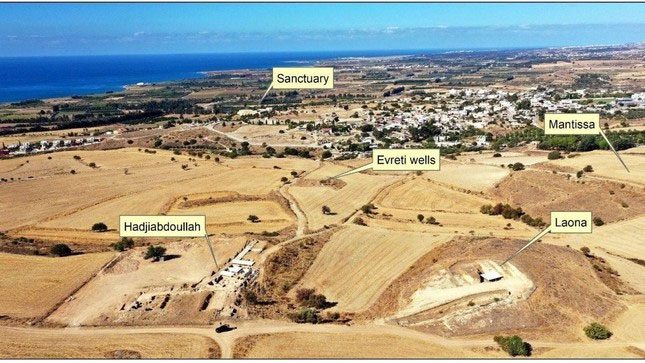Archaeologists excavating a massive ancient burial mound on Cyprus have discovered an even older structure hidden beneath it: a fortification or part of a defensive wall, according to a statement from the Department of Antiquities of Cyprus.
The large earth mounds, known as the Tumulus of Laona, measure over a football field in length, approximately 100 meters long and 60 meters wide, and are believed to have been constructed around the 3rd century BC, during a time when the successors of Alexander the Great were struggling for control over Cyprus and vast territories of the Empire.

Aerial view of the Laona burial mound and surrounding sites on Cyprus.
Researchers have gradually excavated and digitally recorded the Tumulus over the past decade. However, in a recent discovery, archaeologists learned that the tumulus was built atop a damaged fortification that is even older than the mound itself, dating back to the early 5th century BC.
The ancient inhabitants of Cyprus buried the fortress wall under approximately 13,700 cubic meters of loose earth mixed with sand, silt, or clay, known as Marl and red earth, which was transported from elsewhere on Cyprus to construct the tumulus. Consequently, the Laona fortress has been well-preserved beneath the tumulus; its northeastern corner survives to a height of 6 meters, making it one of the most significant remnants of the “Cypriot Kingdom Era”, according to the Department of Antiquities of Cyprus.
“The tumulus is located 1 km northeast of the Aphrodite Sanctuary, an ancient site dating back to the 12th century BC. The mound/tumulus is always visible, but the locals consider it a natural hill,” said Giorgos Papantoniou, an assistant professor of visual and material culture at the University of Dublin, Ireland, who is not involved in the excavation.
The newly discovered area is Cypro-Classical and is noted for the royal dynasty that ruled Paphos until the end of the 4th century BC. Archaeologists report that the wall serves a similar function to the complexes of the Palace and Workshop on Hadjiabdoulla, located just 70 meters from Laona.
In a recent excavation, the Antiquities team uncovered the eastern side of the fortification and two ancient staircases. Further analysis revealed that the fortification faces north beneath the highest point of the mound.
Investigations of the walls indicate that the ancients leveled the ground to begin the project. On this leveled ground is a thick layer of gravel, followed by a layer of red earth containing sherds, or broken pottery pieces. However, it remains unclear who constructed the monument.
“The tumulus was built with local earth and sediments, but since no builders of tumuli from ancient Cyprus have been recorded, the engineers with the necessary expertise were likely not Cypriots, possibly Macedonians,” Papantoniou stated.
Further excavation of parts of the fortification—such as the northern staircase—has been halted due to safety concerns and will focus on the Tumulus. Researchers noted that the construction of the massive burial site would have required a vast and experienced workforce led by specialized engineers. Further studies at Laona will aim to demonstrate that it is a burial mound and attempt to identify who was behind this construction.


















































